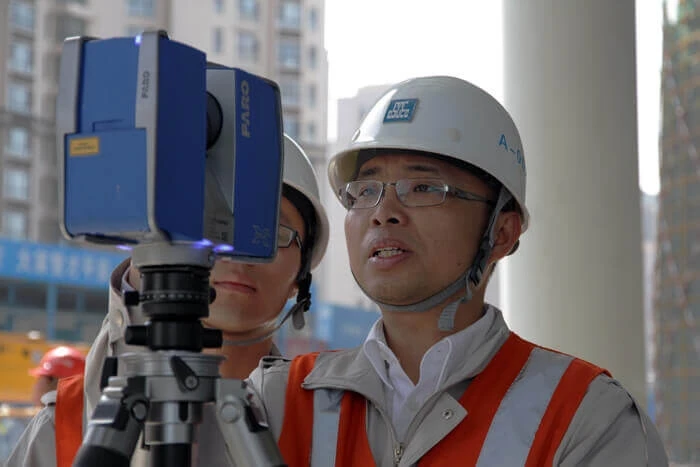& Construction

Integrated BIM tools, including Revit, AutoCAD, and Civil 3D
& Manufacturing

Professional CAD/CAM tools built on Inventor and AutoCAD
Today’s average city dweller has mastered the art of multitasking, and as the world’s most developed cities are looking skyward—creating multiuse supertall buildings that cater to modern life—skyscrapers are becoming great multitaskers themselves. They enhance a city’s skyline, bring connected utilities to urban areas and residents, and use minimal landmass. If done well, sustainable skyscrapers use minimal resources, too.
But how does one construct a sustainable building space that can support businesses, retail, luxury apartments, and a five-star hotel? Can a building be sustainable and opulent? Located in the Binhai New District of metropolitan Tianjin, China (the country’s fourth-largest city), Tianjin Chow Tai Fook Financial Center is, essentially, a city within a skyscraper.
The building is China Construction Eighth Engineering Division Corp., Ltd. (CCEED)’s biggest project to date, standing 530 meters tall, 103 stories high, and featuring a distinctive curved tower facade. An industry leader in sustainability, CCEED conserved resources and minimized waste by using building information modeling (BIM) technology and off-site prefab construction.
With the skyscraper project, CCEED aims to win two of China’s top construction and engineering awards, the Luban Prize and the Zhan Tianyou Prize, and to achieve LEED Gold Certification standards on three sides of sustainability: design, construction, and maintenance/operation of the building—concerns that affect the entire project lifecycle. The project won first place in the construction category of Autodesk’s 2017 AEC Excellence Awards.
Prefab construction is the practice of creating construction components off-site and then transporting them to the job site to be assembled. Some of the benefits of this method of construction include increased safety on construction sites, reduction of weather days, and lower labor costs.
To coordinate the building design with the dizzying system requirements of a mixed-use “city within a skyscraper,” CCEED’s BIM design team of more than 100 people created a centralized model stored on a private cloud server. The model converged nearly 1,000 BIM models and 184,504 components, so creating a singular platform enabled a much more efficient construction process with the global team of stakeholders.
“The construction for Tianjin Chow Tai Fook Financial Center is a very international project because designers came from the United States, Britain, Hong Kong, and other origins,” says CCEED Project Manager Su Yawu, who started his career in skyscraper construction back in 2000.
“Before, we used a traditional construction approach by joining Excel files and the project files with other components for the project planning,” Su says. But with a project on this scale, BIM ensures the far-flung teams can coordinate with local construction companies, read and understand the model easily, and share data in real time with fewer errors.
The project mandated no design changes, storage, or reworking on the construction site, so sticking to the plan required precise coordination with the off-site factory. To meet LEED Gold certification, the CCEED design team’s challenges included outfitting a five-star hotel’s luxury interior with 2,000 types of materials within a sustainable structure. Using BIM, the team was able to use prefab construction to manufacture components precisely according to drawings, thus preventing material waste and eliminating the need to cut materials on-site.
To improve tracking, the team used scannable Quick Response (QR) codes, which contain equipment details, maintenance records, and material certificates. Each model component is tracked with a QR code; 2,950 codes track major equipment and prefab processing components, all automated and managed in the cloud.
“With a QR code, teams can connect their management information with the project’s geometry information,” Su says. “They can then align the information, allowing them to more easily put edits into the BIM platform.”
Sophisticated tools and technology, created using information derived from the BIM model, have been put to work throughout the project. Wiring robots were used to locate pipe support positions and improve installation precision, and virtual reality (VR) was used to train 3,000 of the team’s workers to understand potential risks and learn how to avoid them. VR simulations included falling from great heights and being hit by large objects, driving home the importance of construction safety.
CCEED also used VR to test design elements, such as decoration templates for the hotel and apartment complex. This let designers and owners virtually walk through the finished space, experiencing various materials and design schemes.
Project building information—from fabrication to installation—is integrated and kept up to date. On the ground, the construction crew can use 3D scanning to compare the live jobsite with the BIM model and then modify the model if necessary to align with the physical site’s geographic information system (GIS) tracking. To make these adjustments, drones capture daily images of the site.
For the building’s curtain wall, the Autodesk Revit expansion plug-in Dynamo helped automate geometric elements of the design process by importing its 3D coordinates—speeding up the process and improving accuracy. “We used the design to raise the position data and then generated the curtain-wall-panel geometry automatically,” Su says. “Then we exported this information into Revit and used it as a parameter of assembly to generate the BIM model for the facade.”
The BIM process that guided the design and construction teams will continue to be used to operate and maintain the building. “After the tower has been completed, the team will give the construction BIM model to the owner of the project,” Su says.
To make that possible, CCEED used LOD (Level of Development) 400, which defines the amount of detail available in the BIM model. LOD 400 is more than sufficient for most elements, but for some complex systems—such as mechanical, electrical, and piping—LOD 500 was used to include operational parameters.
“Part of the model needs to be in LOD 500 so that the owner can use the information in the operation and maintenance process,” Su says. In LOD 500, the model is field-verified and contains information clients can use once construction has been completed—especially useful for the varied businesses within the tower.
Designing so many types of spaces, the team unsurprisingly faced many construction challenges—but having one overarching platform has, so far, allowed adjustments to go smoothly. For example, one basement floor is where “many mechanical, electrical, and pumping systems come together,” Su says. “There are over 100 different types of mechanical systems all on one floor, so the team had to lengthen the construction time.”
Su believes that in future skyscraper construction projects, all stakeholders—including construction workers and subcontractors—will need to work with integrated BIM models. “This approach to building will change the way people build buildings and skyscrapers in China and around the world,” Su says.
For the intended end users, projects like Tianjin Chow Tai Fook Financial Center imagine a new way of living and multitasking. There’s still plenty of room for growth—especially on the vertical plane—and it doesn’t have to happen at the expense of the environment. Careful planning and new technology allow companies like CCEED to embrace a streamlined approach, developing supertall structures that cater to the smart folks who dwell and mingle within.
This article has been updated. It originally published in March 2018.
Elizabeth Rosselle is a freelance journalist, copywriter, and designer who splits her time between San Francisco and Bali, Indonesia.
Executive insights
AECO
AECO








